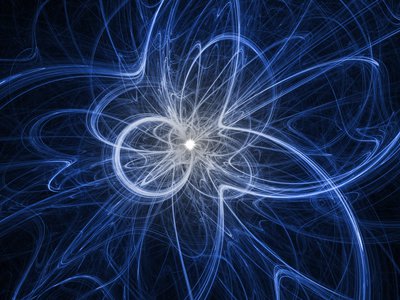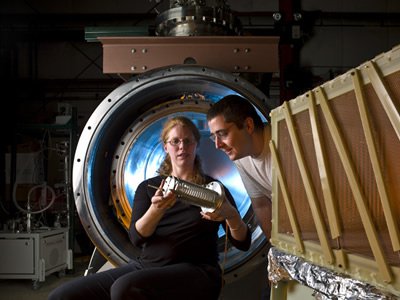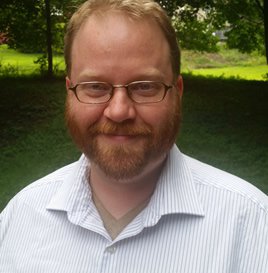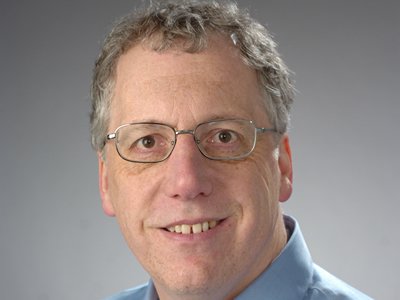Syracuse Revels in Mega-Science Experiment to Study Neutrinos
Professors participate in groundbreaking of Long-Baseline Neutrino Facility in South Dakota, future home of Deep Underground Neutrino Experiment

Physicists in the College of Arts and Sciences are helping usher in a new era of research.
On Friday, July 21, two members of the Department of Physics—Associate Professor Mitchell Soderberg and Assistant Professor Denver Whittington—joined dignitaries, as well as other scientists and engineers from around the world, for a special groundbreaking ceremony at the Sanford Underground Research Facility (SURF) in Lead, South Dakota.
Both professors are part of the Deep Underground Neutrino Experiment (DUNE). The project will occupy the Long-Baseline Neutrino Facility (LBNF), whose construction is officially underway at SURF. When complete, LBNF/DUNE will be the nation’s largest experiment devoted to the study of neutrino properties.
Neutrinos are subatomic particles with no electric charge that are produced by the decay of radioactive elements or heavier subatomic particles. Neutrino particles interact so rarely with other matter that trillions of them pass through our bodies every second without leaving a trace. Unlocking their properties may help explain how the universe works and why matter exists at all.

“LBNF will be a remarkable facility when it’s done,” says Soderberg, estimating construction will wrap in 2027. “We will use DUNE to study neutrinos from a beam originating at Fermilab [short for the Fermi National Accelerator Laboratory, located outside Chicago]. We also will search for more exotic signatures, such as supernovae neutrino bursts and proton decay.”
Soderberg has been involved with DUNE for more than a decade. He has contributed significantly to the development of Liquid Argon Time-Projection Chamber (LArTPC) technology, used in DUNE’s massive neutrino detector.
More recently, Soderberg has led the DUNE Anode Plane Assemblies (APA) working group. APAs are large steel frames, containing thousands of wires that record the ionization of charged particles as they travel through liquid argon inside the DUNE detector.
Each wire connects to an electronic readout channel, which, like a pixel, helps form an image of the particle in the detector. The DUNE detector will have more than 600 APAs.
“When a neutrino hits the nucleus of an argon atom in the detector, it creates a collision that sprays subatomic particle debris. Tracking particles in the debris helps us determine the type and properties of the neutrinos that produced them,” Soderberg says.

Whittington is new to Syracuse, hailing from Indiana University Bloomington, where he has been designing DUNE’s liquid argon scintillation-detection system.
Like Soderberg, Whittington is a high-energy experimental physicist fluent in LArTPC technology. Some of his design work imbues scale replicas of DUNE detectors at CERN (the European Organization for Nuclear Research) in Switzerland.
“When a charged particle interacts with liquid argon, the latter emits a bright signal of a very short wavelength of ultraviolet light,” Whittington says. “I work on the system that converts, channels and collects these signals.”
First predicted in the 1930s and discovered in 1956, neutrinos are the most abundant particles in the universe. Because of their infinitesimal size and lack of electric charge, they are difficult to detect and study. Nevertheless, neutrinos are all around us, constantly changing among one of three states, or flavors, through a process called oscillation. The sun is one of the biggest natural producers of neutrinos.

LBNF will generate beams of neutrinos at Fermilab, sending them more than 800 miles through the Earth to Sanford Lab, where a 70,000-ton, four-story-high detector will try to catch them. The detector, however, will be a mile underground, tucked away from the cosmic rays bombarding the Earth's surface.
"Particles from cosmic rays generate tracks in the detector, complicating the data analysis," Soderberg says. “By having the detector underground, surrounding dirt and rock will stop most of these rays within a short distance.”
As DUNE’s lead laboratory, Fermilab will build both a beam that sends neutrinos—in the “blink of an eye,” Soderberg says—from Illinois to South Dakota and a “near detector” that will record particle interactions at the source of the beam.
CERN is a collaborating laboratory, assisting with the planning, design and construction of the “far detector” at Sanford Lab, built on the former site of the nation’s largest and deepest gold mine. Crews will excavate some 870,000 tons of rock to make room for DUNE’s far detector, whose four modules will hold a total of 68,000 tons of liquid argon.
More than a thousand researchers from over 160 institutions in 30 countries will build and operate the modules in this futuristic underground complex. Among them is Whittington, who hopes to assemble a liquid argon laboratory at Syracuse. Such a lab, he says, will enable him to investigate new technology paradigms, while guiding the construction and commissioning of other DUNE detectors.
“This work will provide excellent opportunities for motivated postdocs, graduate students and undergraduates who want to gain experience with the hardware challenges of experimental high-energy physics,” Whittington adds.
He and Soderberg will use DUNE to look for differences in behavior between neutrinos and their corresponding antiparticles, providing clues as to why matter dominates the visible universe. They also will watch for neutrinos produced by exploding stars—something that might explain the formation of neutron stars and black holes.
“We will investigate whether protons live forever or eventually decay, bringing us closer to fulfilling Einstein’s dream of a grand unified theory,” adds Soderberg, referring to the possible merger of electromagnetism and gravity into different aspects of a single fundamental field.

Alan Middleton, professor and chair of physics, says the groundbreaking brings international distinction to A&S.
“It is an important way to welcome Denver to our faculty and to recognize Mitch, who has been an outstanding contributor to student teaching and mentoring,” says Middleton, also an associate dean in A&S. “We are proud to have such fundamental contributors to the study of neutrinos, which is central to the future of particle physics.”
Streamed live over the internet, the groundbreaking occurred simultaneously at Fermilab and SURF.
Fermilab is the premier national laboratory for particle physics and accelerator research. A U.S. Department of Energy Office of Science laboratory, Fermilab is located near Chicago, and operates under contract by the Fermi Research Alliance.
The Department of Energy Office of Science is the single largest supporter of basic research in the physical sciences in the United States.
The South Dakota Science and Technology Authority operates Sanford Lab with funding from the Department of Energy.
Featured
Mitchell Soderberg Professor and Associate Chair
Denver Whittington Assistant Professor
